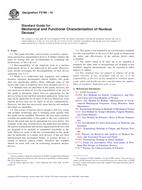Potrebujeme váš súhlas na využitie jednotlivých dát, aby sa vám okrem iného mohli ukazovať informácie týkajúce sa vašich záujmov. Súhlas udelíte kliknutím na tlačidlo „OK“.
ASTM F2789-10
Standard Guide for Mechanical and Functional Characterization of Nucleus Devices
Automaticky preložený názov:
Štandardné Guide pre strojné a funkčné charakterizácia Nucleus zariadenia
NORMA vydaná dňa 1.6.2010
Informácie o norme:
Označenie normy: ASTM F2789-10
Poznámka: NEPLATNÁ
Dátum vydania normy: 1.6.2010
Kód tovaru: NS-54540
Počet strán: 10
Približná hmotnosť: 30 g (0.07 libier)
Krajina: Americká technická norma
Kategória: Technické normy ASTM
Anotácia textu normy ASTM F2789-10 :
Keywords:
dynamic tests, nucleus device, spinal implants, static tests, ICS Number Code 11.040.40 (Implants for surgery, prothetics and orthotics)
Doplňujúce informácie
| Significance and Use | ||||||||||||||||||||||||||||||
|
Nucleus devices are generally designed to augment the mechanical function of native degenerated nucleus material or to replace tissue that has been removed during a surgical procedure. This guide outlines methods for evaluating many different types of devices. Comparisons between devices must be made cautiously and with careful analysis, taking into account the effects that design and functional differences can have on the testing configurations and overall performance, and the possibility that mechanical failure may not be related to clinical failure and inversely, that mechanical success may not be related to clinical success. These tests are conducted in vitro to allow for analysis of the mechanical performance of the nucleus device under specific testing modalities. The loads applied may differ from the complex loading seen in vivo, and therefore the results from these tests may not directly predict in vivo performance. These tests are used to quantify the static and dynamic properties and performance of different implant designs. The mechanical tests are conducted in vitro using simplified loads and moments. Fatigue testing in a simulated body fluid or saline may have fretting, aging, corroding, or lubricating effects on the device and thereby affect the relative performance of tested devices. Hence, the test environment and the effect of that environment, whether a simulated body fluid, normal saline bath (9 g NaCl per 1000 mL H2O), or dry, is an important characteristic of the test and must be reported accurately. Dynamic testing methods should be designed to answer the following questions, including but not limited to: Does the device still function as intended after cycling? Does it retain adequate performance characteristics (for example, mechanical and kinematic properties such as ROM)? Did the device wear or degrade? If there is evidence of wear or degradation of the device, it should be identified and quantified with reasonable methods generally available. The user shall distinguish between particulates generated by the device and particulates generated by the test model and fixtures if technically feasible. |
||||||||||||||||||||||||||||||
| 1. Scope | ||||||||||||||||||||||||||||||
|
1.1 This guide describes various forms of nucleus replacement and nucleus augmentation devices. It further outlines the types of testing that are recommended in evaluating the performance of these devices. 1.2 Biocompatibility of the materials used in a nucleus replacement device is not addressed in this guide. However, users should investigate the biocompatibility of their device separately (see X1.1). 1.3 While it is understood that expulsion and endplate fractures represent documented clinical failures, this guide does not specifically address them, although some of the factors that relate to expulsion have been included (see X1.3). 1.4 Multiple tests are described in this guide; however, the user need not use them all. It is the responsibility of the user of this guide to determine which tests are appropriate for the devices being tested and their potential application. Some tests may not be applicable for all types of devices. Moreover, some nucleus devices may not be stable in all test configurations. However, this does not necessarily mean that the test methods described are unsuitable. 1.5 The science of nucleus device design is still very young and includes technology that is changing more quickly than this guide can be modified. Therefore, the user must carefully consider the applicability of this guide to the user’s particular device; the guide may not be appropriate for every device. For example, at the time of publication, this guide does not address the nucleus replacement and nucleus augmentation devices that are designed to be partially or completely resorbable in the body. However, some of the test recommended in this guide may be applicable to evaluate such devices. It has not been demonstrated that mechanical failure of nucleus devices is related to adverse clinical results. Therefore this standard should be used with care in evaluating proposed nucleus devices. 1.6 This guide is not intended to be a performance standard. It is the responsibility of the user of this guide to characterize the safety and effectiveness of the nucleus device under evaluation. 1.7 The values stated in SI units are to be regarded as standard. No other units of measurement are included in this standard. Angular measurements may be reported in either degrees or radians. 1.8 This standard does not purport to address all of the safety concerns, if any, associated with its use. It is the responsibility of the user of this standard to establish appropriate safety and health practices and determine the applicability of regulatory limitations prior to use. |
||||||||||||||||||||||||||||||
| 2. Referenced Documents | ||||||||||||||||||||||||||||||
|
Odporúčame:
Aktualizácia zákonov
Chcete mať istotu o platnosti využívaných predpisov?
Ponúkame Vám riešenie, aby ste mohli používať stále platné (aktuálne) legislatívne predpisy
Chcete vedieť viac informácií ? Pozrite sa na túto stránku.




 Cookies
Cookies
